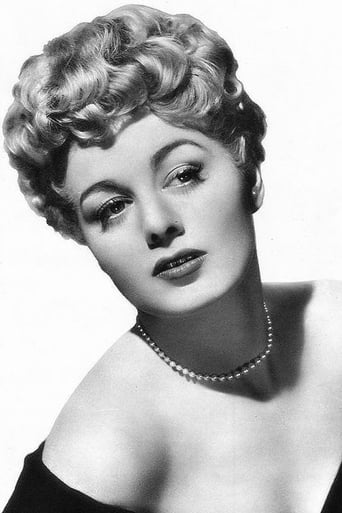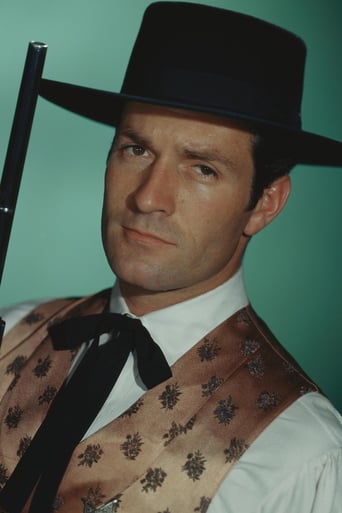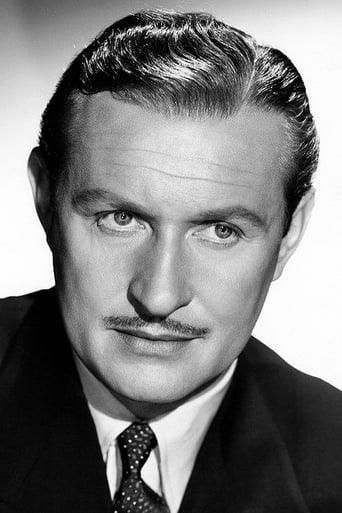Protraph
Lack of good storyline.
Taraparain
Tells a fascinating and unsettling true story, and does so well, without pretending to have all the answers.
Helllins
It is both painfully honest and laugh-out-loud funny at the same time.
Sienna-Rose Mclaughlin
The movie really just wants to entertain people.
Uriah43
This movie begins with two men by the names of "Thomas O'Rourke" (Alan Ladd) and his Cree half-brother "Cajou" (Jay Silverheels) trapping along the banks of the Saskatchewan River in Canada. As they begin to head back home they come across a couple of wagons that had recently been attacked by hostile Indians and discover one female survivor named "Grace Markey" (Shelley Winters) within the ruins. They then decide to take her to a nearby fort. However, she has other plans and tries to steal one of the horses when they aren't paying attention. Unfortunately, as she is making her escape she comes upon a small band of Sioux Indians and has to retreat back to where she started before being rescued again by Thomas and Cajou. Once they get to the fort it is soon disclosed that Thomas is a Royal Canadian Mountie and that the Sioux have just won a decisive engagement with the U.S. 7th Cavalry at the Battle of the Little Big Horn and have advanced north into Canada hoping to enlist the local Cree Indian tribe as allies. Also of interest is the fact that a U.S. Marshall by the name of "Carl Smith" (Hugh O'Brien) has arrived and has an arrest warrant on Grace for the murder of a man in Montana. If that wasn't bad enough, the new Mountie commanding officer named "Inspector Benton" (Robert Douglas) has recently made one bad decision after another which has seriously damaged the peaceful relations the Mounties had with the Cree and given them even more reason into considering an alliance with the Sioux. Now rather than reveal any more I will just say that this started out as a decent Western movie which subsequently developed a severe case of historical inaccuracy the further on it went. For starters, although Chief Crazy Horse was shown in the film trying to recruit the local Cree Indians, the fact is that after the Little Big Horn he never ventured that far north. Neither was Chief Sitting Bull an adversary of the Canadians. As a matter of fact, the Canadian government and Chief Sitting Bull had a healthy respect for one another and he was allowed to stay there in peace. It was only after the decline of the buffalo in the area that he and some fellow Sioux agreed to return to the United States and settle down in a reservation. But historical flaws aside, the film itself was pretty standard for a Western and I have rated it accordingly. Average.
weezeralfalfa
This is one of the spin off films inspired by the 'Custer's Last Stand' saga, that so traumatized the American psyche of the times.The saga of the actual Battle of the Little Bighorn has, of course, been played out on film as a drama or documentary a number of times.In fact, Raoul Walsh, who directed the present film, also directed the classic Errol Flynn-Olivia de Haviland-starring 'They Died with their Boots On' version of this battle. In fact, we might think of the present film as a long-delayed fictionalized sequel to that film, as it deals with the post-Little Bighorn Sioux movement into adjacent Canada and their interactions with the resident Cree. On the other hand, the plot much more resembles 2 other spin offs of the late '40s and early '50s I am familiar with:John ford's 'Fort Apache'and Anthony Mann's 'The Last Frontier'. These 2 films generally get higher ratings than the present film, although 'The Last Frontier' is probably no better known today. That film dealt with the US army's conflicts with the Sioux headed by Red Cloud in a slightly earlier era, just as the Civil War was drawing to a close, and is based on a historical conflict. In 'Forte Apache', the Sioux are replaced by the Apache. In all 3 films, at some point, there is a strong conflict between an 'injin'-savvy subordinate and the company commander who is either naive in dealing with 'injins' or feels duty-bound to deal with them as he believes his distant superiors wish. In the end, the rebel is vindicated. To one who has seen all 3 of these films, clearly 'Fort Apache' is the most entertaining, because of the charisma of the main adversaries(John Wayne and Henry Fonda) and the periodically interjected humor of some of the supporting actors. In contrast, the other 2 films lack any substantial humor to break up the drama, save for Victor Mature's taunting of Robert Preston, who has fallen into a bear trap pit. In 'The Last Frontier', Mature certainly provides a more animated charismatic rebel than the rather stiff monotonic Alan Ladd in the present film. This is the third film of this era I have seen , in which Shelly Winters is the lone white female among a horde of men traveling through a hostile 'injin'-infested West. Usually, she comes across as a hard-bitten floozy, sporting a low-cut dress, although she seems a tad more respectable in the present film.The gorgeous Canadian Rockies scenery is certainly one of the pluses for this film even though, geographically, it has no business being on the route from Saskatchewan to Great Falls, Montana.It was amusing seeing Alan Ladd in his cardinal red RCMP uniform sneaking up on the Cree encampment in broad daylight, in contrast to a much more appropriate drab buckskin outfit of his French Canadian scout. It was difficult for me to tell the Cree from the Sioux by their dress, horse riding and lodges. The Cree were a very diverse and widespread group. The Plains Cree, by necessity, adopted much the same lifestyle as the Plains Sioux, riding horses and living in bison-derived tepees, as opposed to the Woodland Cree, who made wigwams and canoes out of birch bark. By staging most of this film in the Rockies, both the horsemen and canoeing aspects of Cree transport were included. Jay Silverheels, who achieved fame as The Lone Ranger's constant companion in the TV series, again serves as a sometimes companion and confident to the hero. Hugh O'Brian plays a very conflicted character: a US marshal out to capture Shelly's character for the supposed murder of her brother, but who also has the hots for Shelly, to his ultimate demise.
alexandre michel liberman (tmwest)
In 1955 (almost sure) I was stuck with my parents in a line of more than one hour to see this film. Later, when we left the theater we were all satisfied. We had seen a beautiful scenery, Mounties and Indians, on rivers and mountains, plus an entertaining film. Seeing this film yesterday I was happy to realize that after so many years my opinion about it is just the same. Raoul Walsh has to his credit great classic westerns like "Colorado Territory", "Pursued" and "They Died With Their Boots On". "Saskatchewan" is not on their level but is better than many other westerns directed by Walsh. My impression is that the film was shot mostly in Lake Louise and the mountains surrounding it. The scenery is breathtaking and considering Walsh's expertise on grandiose scenes combining the outdoors with hundreds of people on horses you can be sure you are seeing something unique. Ladd is O'Rourke a man that was raised among the Cree and later became a Mountie. Shelley Winters, in one of her best roles is a woman pursued by the law. The Sioux, after Little Big Horn flee to Canada and try to make the Cree join them. Ladd, who knows the Cree better than his superior, does not agree with him, and is on a way to a court martial. The only way he can redeem himself is by proving that his decision was correct. Fom reading other comments I gathered many people were shocked by this film not being accurate neither by the locations where it was filmed, nor by the story. I can understand their point of view, but I still think it is a good film.
ddroesch
I was there on location for this film and it was filmed mostly in Alberta in the vicinity of Lake Louise and Banff. It rained a lot during the filming and a lot had to be redone at the studio. I was an extra and mostly rode horses and was a dead man in several scenes. As a kid it was a great experience.Alan Ladd was wonderful as was Carrol, Shelly and Raoul. They fed us well and we stayed in small out buildings, like motel buildings, near the Banff Springs Hotel. I had to leave early to do a film with Jeff Chandler and I had a commitment at the Pasadena Playhouse at that time also. My last theatre work was in 1960 when I had to give up show business for health reasons --- I needed to eat!Hope this clears up the question of where it was filmed.Don Alan (Droesch)




